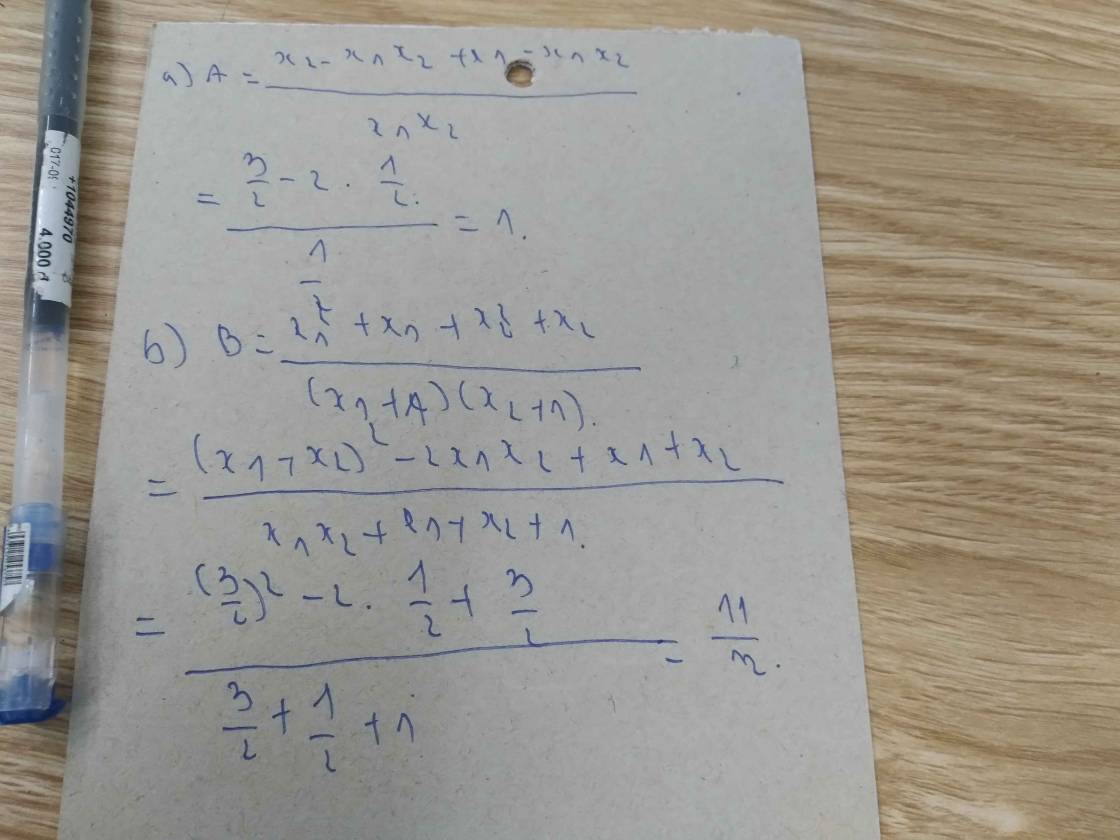

Hãy nhập câu hỏi của bạn vào đây, nếu là tài khoản VIP, bạn sẽ được ưu tiên trả lời.



a: A=x1+x2=-5/2
b: \(=\dfrac{x_1+x_2}{x_1x_2}=\dfrac{-5}{2}:\left(-1\right)=\dfrac{5}{2}\)
c: \(=\left(x_1+x_2\right)^3-3x_1x_2\left(x_1+x_2\right)\)
\(=\left(-\dfrac{5}{2}\right)^3-3\cdot\dfrac{-5}{2}\cdot\left(-1\right)\)
\(=-\dfrac{125}{8}-\dfrac{15}{2}=\dfrac{-185}{8}\)
e: \(E=\sqrt{\left(x_1+x_2\right)^2-4x_1x_2}\)
\(=\sqrt{\left(-\dfrac{5}{2}\right)^2-4\cdot\left(-1\right)}=\sqrt{\dfrac{25}{4}+4}=\dfrac{\sqrt{41}}{2}\)

Nếu đề bài là
Tính P=\(\frac{x_1^2+x_1-1}{x_1}\)-\(\frac{x_2^2+x_2-1}{x_2}\)
Thì lời giải như sau:
Theo định lý Viete, ta có:
x1.x2=-1
Khi đó P=\(\frac{x_1^2+x_1+x_1.x_2}{x_1}\)-\(\frac{x_2^2+x_2+x_1.x_2}{x_2}\)
Do x1 và x2 không thể bằng không nên ta chia tử mẫu của mỗi hạng tử cho x1,x2
Khi đó P=x1+x2+1-(x2+x1+1)=0

\(x^2-4x-6=0\)
\(\text{Δ}=\left(-4\right)^2-4\cdot1\cdot\left(-6\right)=16+24=40>0\)
=>Phương trình này có hai nghiệm phân biệt
Theo vi-et, ta có:
\(x_1+x_2=\dfrac{-b}{a}=\dfrac{-\left(-4\right)}{1}=4;x_1\cdot x_2=\dfrac{c}{a}=\dfrac{-6}{1}=-6\)
\(A=x_1^2+x_2^2=\left(x_1+x_2\right)^2-2x_1x_2\)
\(=4^2-2\cdot\left(-6\right)=16+12=28\)
\(B=\dfrac{1}{x_1}+\dfrac{1}{x_2}=\dfrac{x_1+x_2}{x_1\cdot x_2}=\dfrac{4}{-6}=-\dfrac{2}{3}\)
\(C=x_1^3+x_2^3\)
\(=\left(x_1+x_2\right)^3-3\cdot x_1\cdot x_2\cdot\left(x_1+x_2\right)\)
\(=4^3-3\cdot4\cdot\left(-6\right)=64+72=136\)
\(D=\left|x_1-x_2\right|\)
\(=\sqrt{\left(x_1-x_2\right)^2}\)
\(=\sqrt{\left(x_1+x_2\right)^2-4x_1x_2}\)
\(=\sqrt{4^2-4\cdot\left(-6\right)}=\sqrt{16+24}=\sqrt{40}=2\sqrt{10}\)

a) Áp dụng đl Vi-ét vào pt ta có:
x1+x2=-1.5
x1 . x2= -13
C=x1(x2+1)+x2(x1+1)
= 2x1x2 + x1+x2
= 2.(-13) -1.5
= -26 -1.5
= -27.5
a, Theo Vi et : \(\hept{\begin{cases}x_1+x_2=-\frac{b}{a}=-\frac{3}{2}\\x_1x_2=\frac{c}{a}=-13\end{cases}}\)
Ta có : \(C=x_1\left(x_2+1\right)+x_2\left(x_1+1\right)=x_1x_2+x_1+x_1x_2+x_2\)
\(=-13-\frac{3}{2}-13=-26-\frac{3}{2}=-\frac{55}{2}\)

a: x1+x2=-2; x1x2=-4
x1+x2+2+2=-2+2+2=2
(x1+2)(x2+2)=x1x2+2(x1+x2)+4
=-4+2*(-2)+4=-4
Phương trình cần tìm là x^2-2x-4=0
b: \(\dfrac{1}{x_1+1}+\dfrac{1}{x_2+1}=\dfrac{x_1+x_2+2}{\left(x_1+1\right)\left(x_2+1\right)}\)
\(=\dfrac{x_1+x_2+2}{x_1x_2+\left(x_1+x_2\right)+1}\)
\(=\dfrac{-2+2}{-4+\left(-2\right)+1}=0\)
\(\dfrac{1}{x_1+1}\cdot\dfrac{1}{x_2+1}=\dfrac{1}{x_1x_2+x_1+x_2+1}=\dfrac{1}{-4-2+1}=\dfrac{-1}{5}\)
Phương trình cần tìm sẽ là; x^2-1/5=0
c: \(\dfrac{x_1}{x_2}+\dfrac{x_2}{x_1}=\dfrac{x_1^2+x_2^2}{x_1x_2}=\dfrac{\left(-2\right)^2-2\cdot\left(-4\right)}{-4}=\dfrac{4+8}{-4}=-3\)
x1/x2*x2/x1=1
Phương trình cần tìm sẽ là:
x^2+3x+1=0

a)Có ac=-1<0
=>pt luôn có hai nghiệm trái dấu
b)Do x1;x2 là hai nghiệm của pt
=> \(\left\{{}\begin{matrix}x_1^2-mx_1-1=0\\x_2^2-mx_2-1=0\end{matrix}\right.\) \(\Leftrightarrow\left\{{}\begin{matrix}x_1^2-1=mx_1\\x_2^2-1=mx_2\end{matrix}\right.\)
=>\(P=\dfrac{mx_1+x_1}{x_1}-\dfrac{mx_2+x_2}{x_2}\)\(=m+1-\left(m+1\right)=0\)

a) 2x2 – 17x + 1 = 0 có a = 2, b = -17, c = 1
∆ = (-17)2 – 4 . 2 . 1 = 289 – 8 = 281
x1 + x2 = =
; x1x2 =
b) 5x2 – x + 35 = 0 có a = 5, b = -1, c = -35
∆ = (-1)2 – 4 . 5 . (-35) = 1 + 700 = 701
x1 + x2 = =
; x1x2 =
= -7
c) 8x2 – x + 1 = 0 có a = 8, b = -1, c = 1
∆ = (-1)2 – 4 . 8 . 1 = 1 - 32 = -31 < 0
Phương trình vô nghiệm nên không thể điền vào ô trống được.
d) 25x2 + 10x + 1 = 0 có a = 25, b = 10, c = 1
∆ = 102 – 4 . 25 . 1 = 100 - 100 = 0
x1 + x2 = =
; x1x2 =
a) 2x2 – 17x + 1 = 0 có a = 2, b = -17, c = 1
∆ = (-17)2 – 4 . 2 . 1 = 289 – 8 = 281
x1 + x2 = =
; x1x2 =
b) 5x2 – x + 35 = 0 có a = 5, b = -1, c = -35
∆ = (-1)2 – 4 . 5 . (-35) = 1 + 700 = 701
x1 + x2 = =
; x1x2 =
= -7
c) 8x2 – x + 1 = 0 có a = 8, b = -1, c = 1
∆ = (-1)2 – 4 . 8 . 1 = 1 - 32 = -31 < 0
Phương trình vô nghiệm nên không thể điền vào ô trống được.
d) 25x2 + 10x + 1 = 0 có a = 25, b = 10, c = 1
∆ = 102 – 4 . 25 . 1 = 100 - 100 = 0
x1 + x2 = =
; x1x2 =

1. Theo hệ thức Vi-ét, ta có: \(\left\{{}\begin{matrix}x_1+x_2=-\dfrac{4}{3}\\x_1.x_2=\dfrac{1}{3}\end{matrix}\right.\)
\(C=\dfrac{x_1}{x_2-1}+\dfrac{x_2}{x_1-1}=\dfrac{x_1\left(x_1-1\right)+x_2\left(x_2-1\right)}{\left(x_1-1\right)\left(x_2-1\right)}\)
\(=\dfrac{x_1^2-x_1+x_2^2-x_2}{x_1x_2-x_1-x_2+1}=\dfrac{\left(x_1+x_2\right)^2-2x_1x_2-\left(x_1+x_2\right)}{x_1x_2-\left(x_1+x_2\right)+1}\)
\(=\dfrac{\left(-\dfrac{4}{3}\right)^2-2.\dfrac{1}{3}-\left(-\dfrac{4}{3}\right)}{\dfrac{1}{3}-\left(-\dfrac{4}{3}\right)+1}=\dfrac{\dfrac{22}{9}}{\dfrac{8}{3}}=\dfrac{11}{12}\)
\(1,3x^2+4x+1=0\)
Do pt có 2 nghiệm \(x_1,x_2\) nên theo đ/l Vi-ét ta có :
\(\left\{{}\begin{matrix}S=x_1+x_2=\dfrac{-b}{a}=-\dfrac{4}{3}\\P=x_1x_2=\dfrac{c}{a}=\dfrac{1}{3}\end{matrix}\right.\)
Ta có :
\(C=\dfrac{x_1}{x_2-1}+\dfrac{x_2}{x_1-1}\)
\(=\dfrac{x_1\left(x_1-1\right)+x_2\left(x_2-1\right)}{\left(x_2-1\right)\left(x_1-1\right)}\)
\(=\dfrac{x_1^2-x_1+x_2^2-x_2}{x_1x_2-x_2-x_1+1}\)
\(=\dfrac{\left(x_1^2+x_2^2\right)-\left(x_1+x_2\right)}{x_1x_2-\left(x_1+x_2\right)+1}\)
\(=\dfrac{S^2-2P-S}{P-S+1}\)
\(=\dfrac{\left(-\dfrac{4}{3}\right)^2-2.\dfrac{1}{3}-\left(-\dfrac{4}{3}\right)}{\dfrac{1}{3}-\left(-\dfrac{4}{3}\right)+1}\)
\(=\dfrac{11}{12}\)
Vậy \(C=\dfrac{11}{12}\)